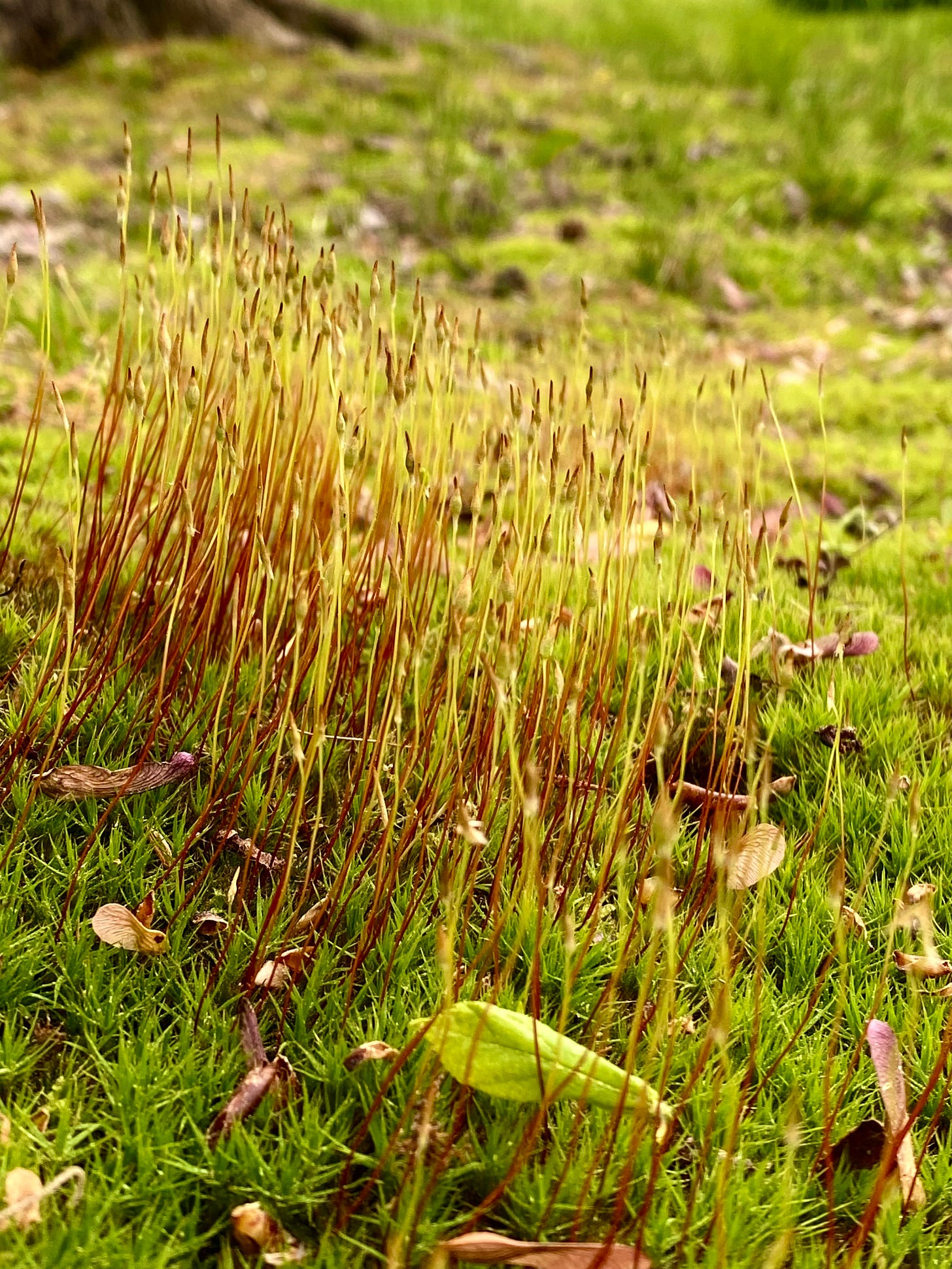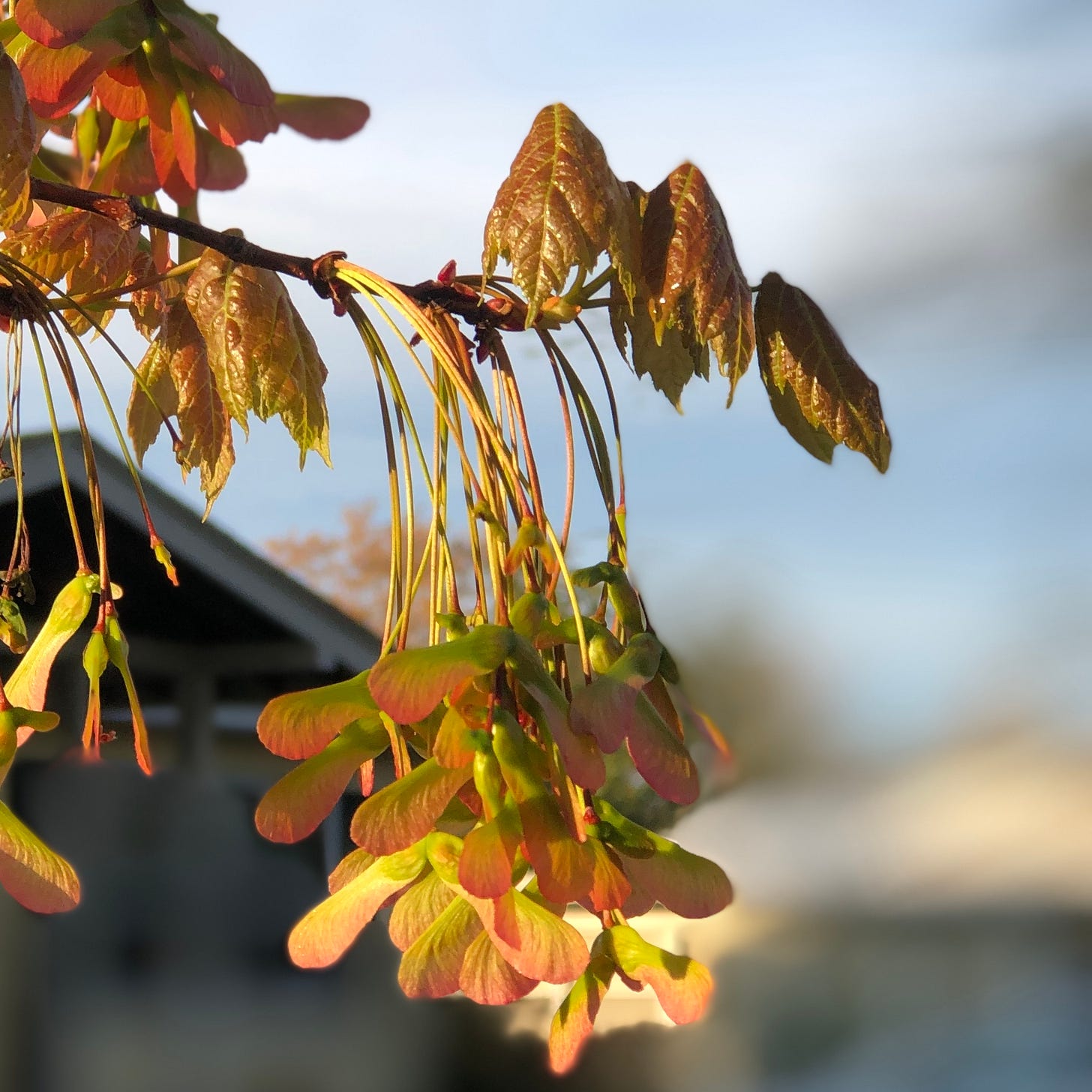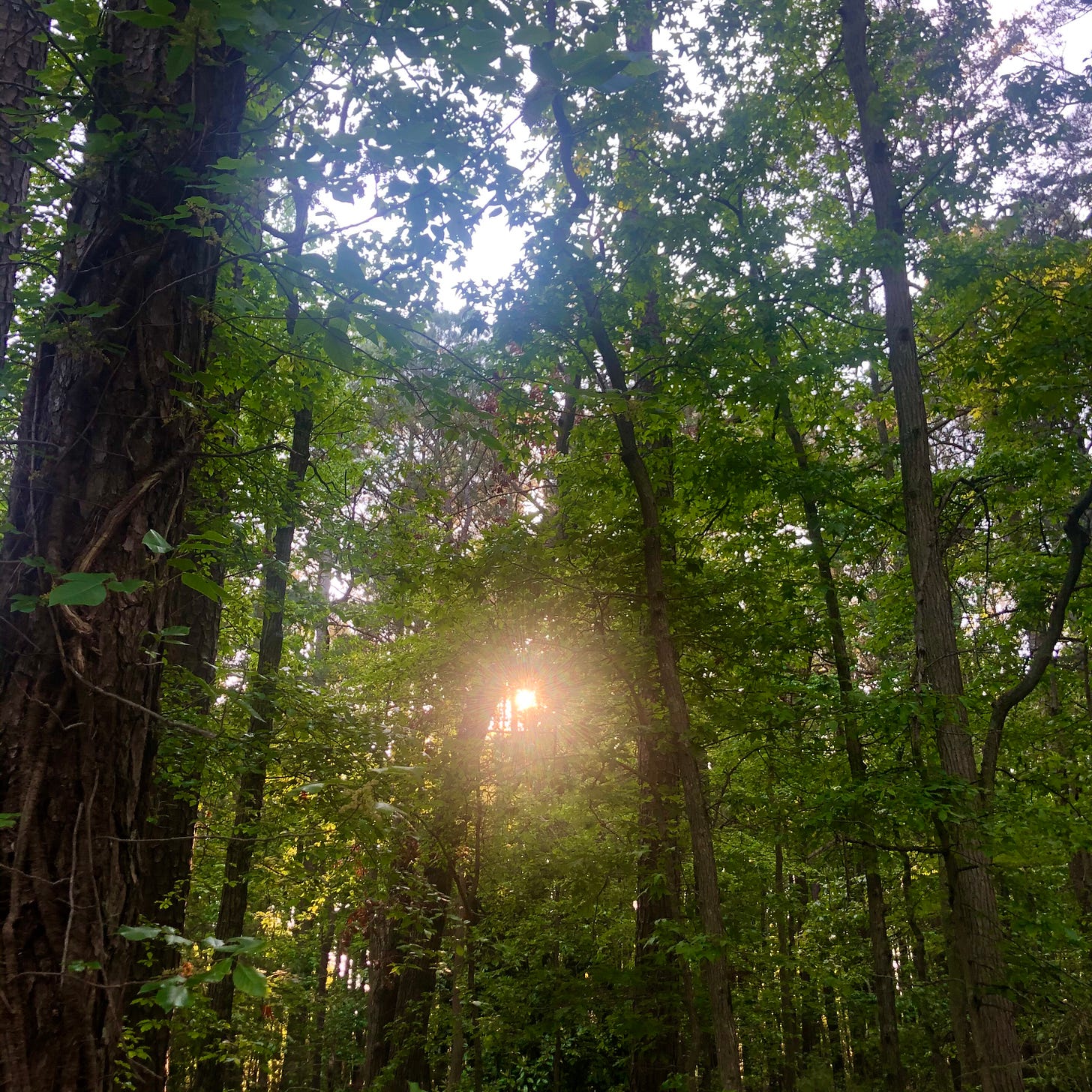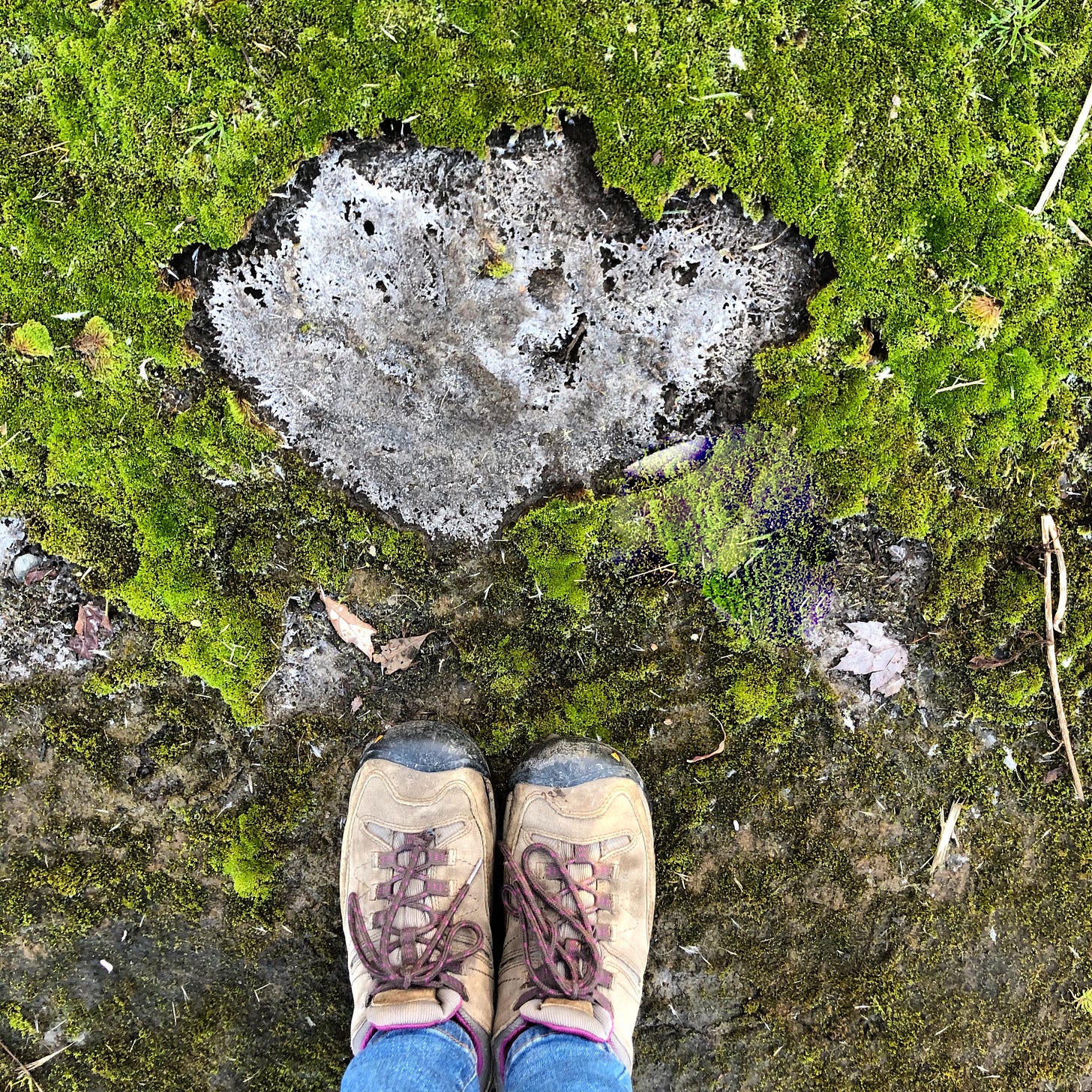We were outside together, but not really. He was sorting out how to attach a shiny, new bell to his old, utilitarian bike, the one with the hi-rise handlebars and funky seat cover, that he uses to tool around town. The one he rescued from someone else’s trash.
I was taking in the character of a spring day, noticing, in particular, the mossy archipelago at the edge of the woods. It’s been warmer than usual, for the season, and too dry, so there are areas of brown in among the green, and clumps that that look detached and dusty, like they’ve just come from the outback and haven’t yet re-assimilated.
“What are you doing?” he asked, quizzically, when he saw me stretched out under a tree.
“Just appreciating the moss,” I said.
I stayed there for a long while, admiring the flocculent colonies of plants, many resembling tiny fir forests. I stroked a patch of spore-topped strands and was reminded of the pets I’ve caressed, the babies whose fuzzy heads I’ve cuddled, and the feather-headed critters I’ve nurtured over the years.
There was a time when this kind of vegetative communion, albeit with cultivated species, was tied directly to my livelihood. Now, instead, I am paid to support other farmers in similar roles. But, my reverence for plants, our everyday superheroes, remains. They are nothing short of incredible. In fact, they’re the reason we exist at all.
From their earliest forms as aquatic species, terrestrial plants are estimated to have evolved around 700 million years ago, among them rootless liverworts and mosses, which are credited with making Earth habitable by reducing carbon dioxide and increasing oxygen. As populations of simple species like theirs increased, they simultaneously diversified, adapting to a wider range of environments, especially those with less moisture. New groups emerged, with vascular systems capable of transporting water from roots to stems, like ferns and gingkoes, conifers and, eventually, maple trees. At some point, animals got in on the party, feasting on the abundant plant life and evolving into – well, us, among other creatures.
We’ve come a long way, baby. Yet, despite all the biological and technological advancements since our humble beginnings, we humans are still utterly reliant on plants for our survival. Perhaps this dependence, juxtaposed as it is against our presumed dominion, is what drives our resistance to the idea of plants possessing forms of intelligence.
Last month, Israeli researchers reported in a scientific journal that “plants emit airborne sounds [which] can be detected from more than a meter away.” While we’ve known for years that noises like this serve as a form of communication, until now it was not understood that the sounds were airborne, capable of being heard by other plants and animals. This was big news, as was the associated finding that the emissions were stress-driven. The more strained the plants, the more sounds they made.
“…Tomato and tobacco plants that are stressed—from dehydration or having their stems severed—emit sounds that are comparable in volume to normal human conversation. The frequency of these noises is too high for our ears to detect, but they can probably be heard by insects, other mammals, and possibly other plants.”
Scientists believe the clicking noises are the result of pockets of air popping in the plant’s water transport system. They’re stressed, and their bubbles are bursting. I feel you, plant friends. I feel you.
These were far from the first researchers to come to related conclusions. In their 1973 book, The Secret Life of Plants, Peter Tompkins and Christopher Bird presented evidence, much of it later refuted by respected botanists, that plants are sentient beings.
In 2006, six scientists authored a paper in which they explored plant neurobiology, or the mechanisms used to send internal and external messages, processes reliant upon the production of chemicals similar to those generated by brain-possessing animals. In other words, plants might have more smarts than we thought. Or so the researchers suggested. Beloved (in many of my circles, anyway) journalist and author, Michael Pollan, investigates their and many other’s efforts to quantify and decode such communications in The Intelligent Plant, a thorough and fascinating article written for The New Yorker in 2013.
In 2015, Peter Wohlleben wrote The Hidden Life of Trees. It was his sixteenth attempt to parlay his views on gentle forest management and respect for trees to an audience, he hoped, of future advocates. And, it was his first real success. The book became a bestseller, spawning a podcast, a magazine, a film documentary, and a television show. Not long after, critics tore it limb from limb, accusing the author of shoddy science and of anthropomorphizing his subjects.
As recently as four years ago, communities of tree-loving humans were chattering with excitement over research from Stefano Mancuso, one of the six scientists on the 2006 plant neurobiology team, which seemed, once again, to support evidence of trees having a social network through which they share resources, communicate incoming threats, and on occasion, sabotage one another. The system was coined the “wood wide web,” and everyone from scientists to environmentalists was reinvigorated around the notion of talking trees. Sadly, just ahead of last week’s bubble-popping breakthrough, the science used to shape the forest internet concept came under fire.
I wonder how long it will take before someone chops down the airborne distress-signal findings from March. What is it about this kind of research that generates such a backlash? Is the pushback really rooted in efforts to quell inferior scientific processes, or does it, instead, stem from our anthropocentric views? Plants have shown evidence of a capacity to learn from experience, make choices, solve problems and communicate. Science has given us examples time and again. What really seems to be at odds with the research is our willingness to believe that nature is complex, adept, and intelligent, for this calls into question our human sovereignty.
“This is What It Sounds Like When Plants Cry,” one headline read. Another, “Silent screams: New research finds plants 'cry' when stressed.” I learned of the new plant-sounds study just days after a school shooter in Nashville, armed with assault weapons, took the lives of three children - Evelyn, Hallie and William – and three adults – Katherine, Mike, and Cynthia.
As I mourned, I thought about how much damage we humans inflict on each other and the planet every minute of every day. I imagined the anguish hemorrhaging from the broken hearts of the grieving parents. I considered the urgent signals emanating across our landscapes from plants affected by too little or too much water, too many chemicals, a lack of diversity, invasive pests. Everything, everywhere must be crying. Though we can’t necessarily hear it, I’m convinced we experience it, in the core of our being, as a kind of collective agony.
What can anyone do? What can any one do? We can work against our tendencies to prioritize human life at all costs. We can remember how connected we are to everything else, and how dependent on each other - every kind of other. We can tell the story of how we are not so different, after all, from those with whom we co-exist. We can persist in our efforts to see non-humans as deserving of equal respect. We can teach our children, and their children, to appreciate moss. We can invite them to sit beside us, under a tree. We can tell them how the plants came first.
~Elizabeth
p.s. Even if you can’t make time to dig into the various links in this week’s essay, I hope that, as an Earth Day gift to yourself, you’ll carve out a few quiet moments, maybe outdoors in a space that feels both safe and expansive, to experience this marvelous production from Emergence Magazine. In it, mythologist Martin Shaw summons an ancient story, “of a wild daughter who falls in love with a bear. In short film vignettes, with a vivid oral storytelling and hand-drawn imagery, this multimedia feature takes us on a perilous journey that invites us back into call-and-response with the more-than-human world.”









The spirituality and mystery of communication....All things...all people. .. Beautifully written. Thank you
I feel the connection like a mutual admiration in my garden, whether it’s planting, watering, weeding or simply observing. I care and am rewarded with life.